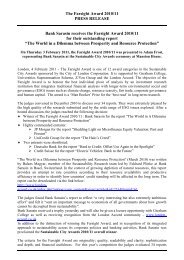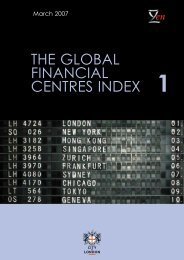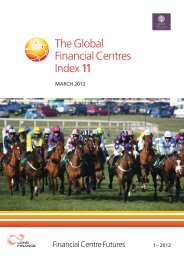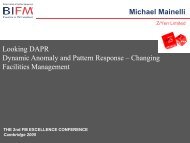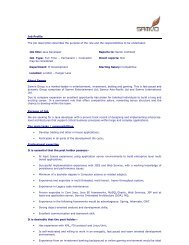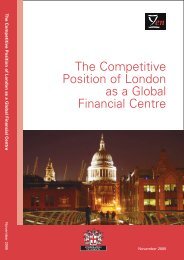The global financial centres index (GFCI) 3 - Z/Yen
The global financial centres index (GFCI) 3 - Z/Yen
The global financial centres index (GFCI) 3 - Z/Yen
Create successful ePaper yourself
Turn your PDF publications into a flip-book with our unique Google optimized e-Paper software.
<strong>The</strong> Global Financial Centres Index<br />
all significant international <strong>financial</strong> <strong>centres</strong>.<br />
Source: Dariusz Wojcik – Oxford<br />
University Centre for the Environment and<br />
St. Peter’s College<br />
<strong>The</strong> International Finance Location Quotient,<br />
Dariusz Wojcik (June 2007) – This displays the<br />
relation of a country’s share in international<br />
<strong>financial</strong> services to its share of GDP in a<br />
sample of 41 countries that account for 91% of<br />
world’s GDP (i.e. all major world economies).<br />
Countries with high IFLQ have a developed<br />
international <strong>financial</strong> services sector but the<br />
higher the score, the more dependent their<br />
economy is on international <strong>financial</strong> services.<br />
Source: Dariusz Wojcik – Oxford<br />
University Centre for the Environment<br />
and St. Peter’s College<br />
<strong>The</strong> International Finance Diversity Index,<br />
Dariusz Wojcik (June 2007) – This is a measure of<br />
the diversification of a country’s international<br />
<strong>financial</strong> services sector. Financial services are<br />
divided into four major groups: external bank<br />
loans and deposits, international debt<br />
securities, trading of cross-listed stocks and<br />
over-the-counter foreign exchange plus<br />
derivatives based on interest rates. <strong>The</strong> more<br />
these services are diversified the higher the<br />
value of the <strong>index</strong>, a value of 1 meaning that<br />
the four major groups are equally diversified<br />
and a value of 0 meaning that the relevant<br />
country’s whole international <strong>financial</strong> sector is<br />
based on only one of these groups.<br />
Source: Dariusz Wojcik – Oxford<br />
University Centre for the Environment and St.<br />
Peter’s College<br />
prime office locations, covering 111 business<br />
districts in 43 countries worldwide, comparing<br />
the occupancy costs per workstation as<br />
opposed to unit area, in order to better reflect<br />
the true costs of accommodation. To facilitate<br />
ranking on a <strong>global</strong> scale, total occupancy<br />
costs per workstation are expressed in US$.<br />
Source: www.propertyoz.com.au<br />
Office Space Across <strong>The</strong> World, Cushman &<br />
Wakefield (February 2007) 1 – A report<br />
focusing on occupancy costs across the globe<br />
over the preceding twelve months, ranking the<br />
most expensive locations in which to occupy<br />
office space.<br />
Source: www.cushmanwakefield.com<br />
Competitive Alternatives Survey, KPMG<br />
(January 2006) – A measure of the combined<br />
impact of 27 cost components that are most<br />
likely to vary by location, as applied to specific<br />
industries and business operations. <strong>The</strong><br />
eight-month research programme covered<br />
128 <strong>centres</strong> in nine industrialised countries,<br />
examining more than 2,000 individual business<br />
scenarios, analysing more than 30,000 items of<br />
data. <strong>The</strong> basis for comparison is the after-tax<br />
cost of start-up and operations, over ten years.<br />
Source: www.competitivealternatives.com<br />
Offices With Air Conditioning, Gardiner &<br />
<strong>The</strong>obald (June 2007) – Using data from the<br />
International Construction Cost Survey.<br />
<strong>The</strong> <strong>GFCI</strong> uses the mid point of the lowest and<br />
highest cost of an office with air conditioning<br />
(given in US$ per square foot).<br />
Source: www.gardiner.com<br />
Relative Global Network Connectivity,<br />
Mastercard (March 2007) – This study examines<br />
the patterns of connection between <strong>centres</strong><br />
through the office networks of 100 leading firms<br />
offering specialised corporate services to the<br />
<strong>financial</strong> sector (including law, advertising,<br />
consulting, accounting and insurance).<br />
Source: www.mastercard.com<br />
Instrumental Factors for Infrastructure<br />
Global Office Occupancy Costs, DTZ (June<br />
2007) – A guide to accommodation costs in<br />
European Cities Monitor, Cushman & Wakefield<br />
(October 2007) 1 – An annual study examining<br />
the issues that companies regard as important<br />
in deciding where to locate their business.<br />
<strong>The</strong>re are a total of twelve issues and the<br />
overall scores are based on survey responses<br />
from 507 companies in nine European<br />
countries, with each respondent ordering the<br />
twelve issues in terms of importance.<br />
A weighting system is then used to determine<br />
the overall city scores.<br />
Source: www.cushmanwakefield.com<br />
71




